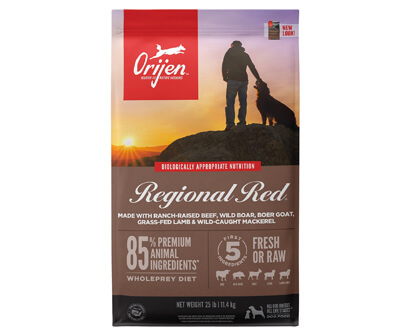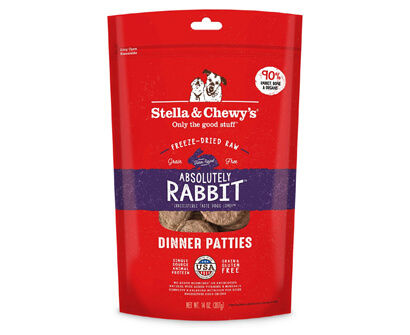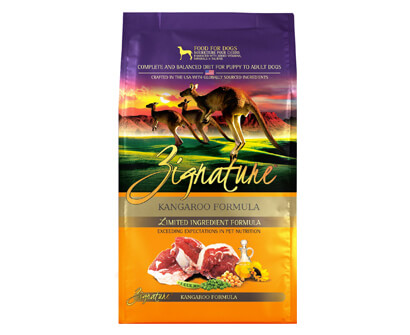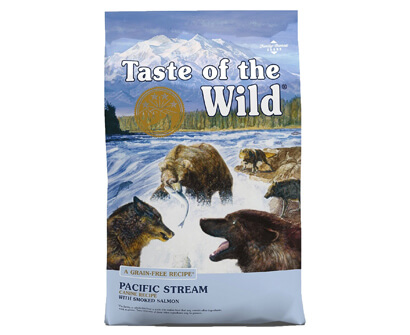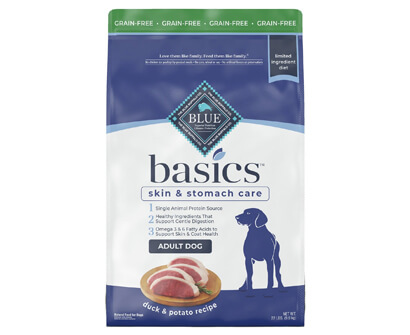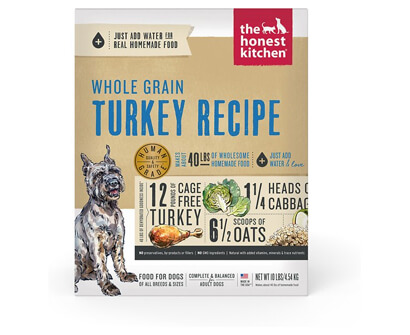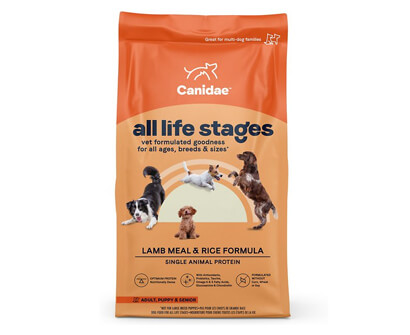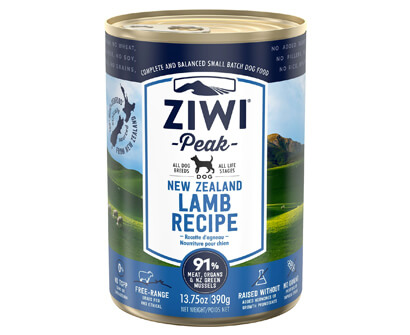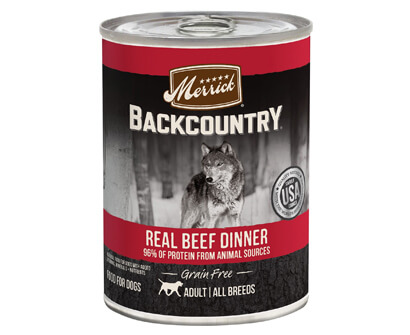- Key Takeaways
- 1. ORIJEN Regional Red Grain-Free Dry Dog Food
- 2. Diamond Skin & Coat Salmon Dry Dog Food
- 3. Stella & Chewy’s Absolutely Rabbit Dinner Patties Freeze-Dried Raw Dog Food
- 4. Zignature Kangaroo Limited Ingredient Grain-Free Dry Dog Food
- 5. Taste of the Wild Grain-Free Dry Dog Food
- 6. Blue Buffalo Basics Skin & Stomach Care Grain-Free Dry Dog Food
- 7. The Honest Kitchen Whole Grain Turkey Recipe
- 8. CANIDAE All Life Stages Lamb Meal & Rice Formula
- 9. Ziwi Peak Lamb Recipe Canned Dog Food
- 10. Merrick Backcountry Grain-Free Real Beef Dinner Recipe
Chicken allergies in dogs are actually more common than you might think. Many dogs develop protein allergies as they're growing as a result of exposure to a single protein for a prolonged amount of time, which is easily done when you find a food that works! But what if your dog can no longer eat their normal food? Fortunately, a lot of dog food brands offer dog foods without chicken, with some even using novel animal proteins such as bison and venison for those pups with severe protein allergies.
So if your dog has developed this less common of food allergies, we're here to show you your options with ten of the best dog foods for chicken allergies.
Key Takeaways
- Any dog can develop a chicken allergy during its lifetime.
- Removing all poultry from your dog's diet is best for severe allergies.
- Grain-free dog food can be good for settling an already sensitive stomach.
- Food high in omega fatty acids help your dog's skin to recover from a food allergy reaction.
Our Top 10 List
1. ORIJEN Regional Red Grain-Free Dry Dog Food
Key Features
Brand: Orijen
First 5 ingredients: Beef, Wild Boar, Goat, Lamb, Lamb Liver
Primary Proteins: Beef, Wild Boar, Goat, Lamb, Mutton, Mackerel, Herring
Calories: 463 kcal/cup
Flavor: Regional Red (Beef, Board, Goat, Lamb, and Mackerel)
Life Stage: All Life Stages
Orijen is recognized as one of the top-quality dog food brands on the market today. This food is excellent for particularly muscular breeds that need plenty of protein to maintain muscle mass and recovery after an active day. This is because the ingredients list is chock full of a tremendous range of proteins that will not only create an interestingly diverse flavor but also equate to 38% crude protein in the overall formula.
Orijen have backed up their various fresh proteins with additional protein meals such as lamb meal, goat meal, and more, as well as including the organs of the various animals for a more natural and accurate diet. They’ve also bolstered and balanced this protein-rich recipe with an abundance of fresh fruit and vegetables such as apples, pears, navy beans, chickpeas, butternut squash, collard greens, and juniper berries.
Pros
The first eleven ingredients are different types of fresh animal protein.
The flavors are varied, exciting, and loved by most dogs.
Cons
The bag isn’t resealable so the food needs to be transferred into a sealed food container.
2. Diamond Skin & Coat Salmon Dry Dog Food
Key Features
Brand: Diamond Naturals
First 5 ingredients: Salmon, Fish Meal, Potatoes, Lentils, Peas
Primary Proteins: Salmon, Fish
Calories: 408 kcal/cup
Flavor: Salmon & Potato
Life Stage: All Life Stages
Diamond Naturals has been a favorite of ours for some time. This delicious dog food brand had developed a tremendous range of foods to suit a wide variety of needs and allergies. This particular food is aimed at the recovery and maintenance of the skin and coat. Many dogs that experience food allergies will lose the quality of their coat owing to allergy-triggered skin conditions, and this food aims to rectify that problem.
There is no poultry of any kind in the recipe, and the key proteins, salmon and fish meal, are rich sources of omega fatty acids – the key components to bettering your dog’s skin via their diet. This is also a well-balanced diet stuffed with nutrients and minerals from various vegetable sources.
3. Stella & Chewy’s Absolutely Rabbit Dinner Patties Freeze-Dried Raw Dog Food
Key Features
Brand: Stell & Chewy’s
First 5 ingredients: Rabbit With Ground Bone, Olive Oil, Rabbit Liver, Pumpkin Seed, Organic Cranberries
Primary Proteins: Rabbit
Calories: 53 kcal/patty
Flavor: Rabbit
Life Stage: Adult Dogs
Completely unique on our list of food options. These Stella and Chewy’s patties are made up of raw rabbit’s meat (along with other ingredients), that have then been freeze-dried and packaged. They can be served as they are, or if you’re wanting to give your pup a little bit more texture in their meal you can add 1/4 cup of water to two crumbled patty.
These are a delicious alternative to your standard dog foods. Additionally, the recipe itself is made up of a wealth of natural nutritional ingredients including spinach, broccoli, beets, carrots, squash, and blueberries all of which provide various vitamins, minerals, and antioxidants to bolster your dog’s immune system and protect their overall health.
Pros
A natural, simple recipe full of flavor with high nutritional value.
A unique food idea that is versatile and mimics a natural raw feed diet.
Cons
Not ideal for larger dogs as the number of patties required per meal would be too expensive.
4. Zignature Kangaroo Limited Ingredient Grain-Free Dry Dog Food
Key Features
Brand: Zignature
First 5 ingredients: Kangaroo, Kangaroo Meal, Chickpeas, Peas, Sunflower Oil
Primary Proteins: Kangaroo
Calories: 396 kcal/cup
Flavor: Kangaroo
Life Stage: Adult Dogs
Zignature’s limited ingredient kangaroo diet combines the use of a novel protein with the design of a limited diet for dogs having to go through the food elimination trials. If you’re having trouble figuring out exactly what’s causing the symptoms your dog is experiencing, or if they still seem to struggle after changing their diet, this would definitely be worth a try.
The use of kangaroo in place of poultry means the protein source is almost guaranteed to not cause an allergic reaction. Furthermore, this is a simple, grain-free recipe that uses high-quality ingredients and has animal protein prioritized as the first two ingredients on the list. Just be mindful that this food is meant for adult dogs, not adolescent developing dogs or puppies.
Pros
Has kangaroo protein as the first two ingredients on the list.
Ideal for dogs with multiple food allergies as it is also grain-free.
Cons
Not especially budget-friendly due to the specialist nature of the recipe.
5. Taste of the Wild Grain-Free Dry Dog Food
Key Features
Brand: Taste of The Wild
First 5 ingredients: Salmon, Ocean Fish Meal, Sweet Potatoes, Potatoes, Peas
Primary Proteins: Salmon, Ocean Fish
Calories: 408 kcal/cup
Flavor: Smoked Salmon
Life Stage: Adult Dogs
Taste of the Wild’s grain-free formula provides a fun take on the dog’s natural diet. As opposed to basing this on a raw-feed beef-based diet, they have instead decided to go for a natural diet of pacific fish, with salmon as the first ingredient. This food is highly digestible thanks to the use of sweet potato as a major ingredient, meaning your dog should be able to process it with no problems.
This is also an omega fatty acid-rich formula. The use of salmon and ocean fish guarantees that your dog will be receiving the essential nutrients for better coat and skin health, meaning it should help them to recover from any allergy-based skin affliction. This is an adult-only diet, however, and not recommended for newly weaned puppies or young dogs.
Pros
Highly digestible with plenty of omega fatty acids for skin and coat health.
Small biscuits that can be eaten easily by smaller breeds.
Cons
It’s quite heavy on the use of potato in replacement of grain elements.
6. Blue Buffalo Basics Skin & Stomach Care Grain-Free Dry Dog Food
Key Features
Brand: Blue Buffalo Basics
First 5 ingredients: Deboned Duck, Potatoes, Pea Starch, Peas, Pea Protein
Primary Proteins: Duck
Calories: 354 kcal/cup
Flavor: Duck
Life Stage: Adult Dogs
Blue Buffalo’s basics range includes multiple recipes designed to benefit dogs in various areas of their health. We have chosen this particular recipe for its focus on recovery and skin and stomach health. However, we must also highlight that though this is not a chicken recipe, it is a duck recipe, and so we wouldn’t recommend it for owners wishing to completely remove poultry from their dog’s diet.
We like the fact that they have got deboned duck as the first ingredient, and that they have included pea protein for additional muscular support as well as providing a rich source of fiber for easier digestion. This is also a low-calorie option when compared to some others on our list and can therefore be used with pups that may struggle with excess weight gain.
Pros
Low-calorie for dogs that are prone to excessive weight gain.
Contains high fiber for maximum digestibility and to encourage nutrient absorption.
Cons
Not suitable for dogs with a general poultry allergy as duck is an allergen.
7. The Honest Kitchen Whole Grain Turkey Recipe
Key Features
Brand: The Honest Kitchen
First 5 ingredients: Dehydrated Turkey, Organic Oats, Dehydrated Potatoes, Organic Flaxseed
Primary Proteins: Turkey
Calories: 470 kcal/cup
Flavor: Turkey Recipe
Life Stage: Adult Dogs
The Honest Kitchen’s whole-grain turkey recipe has made it on to our list for those pups that don’t experience anything more than a chicken allergy (though it is unsuitable for dogs with poultry allergies). Whole grains have a wealth of nutritional uses in dog food and should not be avoided unless you have a specific need to avoid them.
This who grain recipe boasts turkey as the first recipe, quickly followed by organic oats which are a fantastic source of natural carbohydrates than can be easily broken down and provide plenty of energy for active pups. For dogs without a grain aversion, this food is highly digestible and filled with balance nutrition for better overall health.
Pros
Utilizes all of the natural nutritional value, protein, and carbs provided by grains.
The Honest Kitchen also offers grain-free alternatives in different flavors.
Cons
Not suitable for dogs with a general poultry allergy or grain-related allergies.
8. CANIDAE All Life Stages Lamb Meal & Rice Formula
Key Features
Brand: CANIDAE
First 5 ingredients: Lamb Meal, Peas, Brown Rice, Barley, Oatmeal
Primary Proteins: Lamb
Calories: 502 kcal/cup
Flavor: Lamb Meal & Rice
Life Stage: All Life Stages (not large breed puppies)
CANIDAE’s lamb meal and rice formula has proven highly digestible and the perfect alternative to chicken or poultry-based food. With lamb meal as the first ingredient, it’s guaranteed to be high in protein to keep young pups strong during their active days. Just keep in mind that this is a grain-inclusive recipe, so perhaps not ideal for dogs with grain allergies.
Additionally, the use of peas and brown rice bring fiber to this delicious food which will not only help your pup to go more easily, but it will also ensure that they are properly absorbing the nutrients and gaining the full benefit of every ingredient, including the better breakdown of carbohydrates for energy.
Pros
The high caloric density means less food is needed for each meal.
Suitable for dogs at all life stages including younger more sensitive dogs.
Cons
Uses lamb meal instead of fresh lamb for the first ingredient.
9. Ziwi Peak Lamb Recipe Canned Dog Food
Key Features
Brand: Ziwi Peak
First 5 ingredients: Lamb, Water Sufficient for Processing, Lamb Lung, Lamb Kidney, Chickpeas
Primary Proteins: Lamb, Mussel
Calories: 517 kcal/13.75-oz can
Flavor: Lamb
Life Stage: All Life Stages
Ziwi Peaks’ lam recipe canned food is a delicious recipe that hugs as closely to the natural diet that a dog would have should it hunt lamb in the wild. This means Ziwi Peaks have used the lungs, kidneys, liver, tripe, heart, and bone of the animal as well. Each ingredient provides its own nutritional benefits, therefore limiting the number of additional ingredients that are necessary to fill the remainder of the formula.
Once you remove the lamb from the recipe you are left only with nutrient balancing added vitamins as well as a couple of simple added ingredients such as chickpeas and mussels to round out the recipe. This food has proven to be quite irresistible for dogs of all ages, as it is not only flavorful but natural. Furthermore, the high caloric content ensures your dog is getting its meal’s worth with every bite.
Pros
Great for providing additional hydration for dogs that don’t drink enough.
The texture of flavor of canned food is much more appetizing than dry food.
Cons
A more expensive option than other dry dog foods.
10. Merrick Backcountry Grain-Free Real Beef Dinner Recipe
Key Features
Brand: Merrick
First 5 ingredients: Deboned Beef, Beef Broth, Beef Liver, Dried Egg Product, Natural Flavor
Primary Proteins: Beef
Calories: 395 kcal/12.7 oz can
Flavor: Real Beef Dinner
Life Stage: Adult Dogs
Merrick’s backcountry recipe consists of 96% animal protein, meaning your dog is getting a pretty accurate representation of a natural meal. This is even a grain-free recipe for those slightly more sensitive pups that may struggle with grain sensitivities. This can not only be served as its own entree, but it also makes an excellent mixer with dry kibble too.
Much like Ziwi Peaks, this is an extremely minimal recipe containing most animal protein with some added vitamins, minerals, and simple ingredients to full out the flavor and nutritional benefit of this diet. However, this is a slightly more low-calorie option for dogs that may struggle with gaining unwanted weight.
Pros
Great for encouraging full eaters to eat their meals more readily.
Has beef as the first three ingredients on the formula list.
Cons
Contains dried egg product as one of the top five ingredients.
Best Chicken Free Dog Food: Buyer's Guide & FAQs
Signs of Chicken Allergy in Dogs
There are so many dog food allergies that many owners are completely unaware of, with protein allergies being top of the list. But getting your pup tested for food allergies can be an intimidating prospect - and often quite expensive. So it might be worth knowing the signs and symptoms you should look for and everything you should do before going to get your dog tested in order to streamline the process.
Symptoms
The symptoms of a chicken allergy can vary quite dramatically depending on the severity of the allergy, but generally include the following to some capacity:
- Vomiting or retching
- Diarrhea
- Itching and hot spots
- Excessive self-grooming
- Excessive scratching
- Ear infections
- Rashing or hives
- Difficulty breathing or wheezing
- Coughing
- Bald patches
- Excessively biting at paws
- Stunted growth
- Pawing at face
- Chronically inflamed feet
- Skin infections
- Excessive head shaking
- Irritability
- Refusal to eat
- Hypersensitivity to being touched
Some of these symptoms may be more prevalent than others, though the most common are usually skin-related reactions such as itching and hot spots, or digestion relation such as runny stools or vomiting.

What to Avoid With a Chicken Allergy
Chicken allergies can be parter of a larger poultry allergy or a very specific allergy targeting chicken specifically. With a general poultry allergy there are a few additional things you should avoid as well as chicken:
- Duck
- Turkey
- Poultry protein
- Poultry meal
- Poultry by-product meal
- Chicken meal
- Pheasant
- Game birds
- Ostrich
- Quail
Even if a dog food is not labeled as chicken flavored, there is still a high chance it could contain chicken meal as a protein-boosting ingredient. Be sure to check the ingredients of any food that you buy before committing to purchasing it to ensure chicken is not present in the recipe.
Other Protein Options for Dogs Allergic to Chicken
So if you're wanting to err on the side of caution and stick to alternative proteins that are not even close to poultry, there is a large range of alternatives you could choose from. The classic poultry-free flavors include:
- Pork
- Beef
- Lamb
- Fish
Or you could go for a novel protein if you're wanting to give your pup an extra treat. Though be aware that most novel proteins options do tend to be more on the expensive side as they're less common and usually part of a specialized diet:
- Bison
- Rabbit
- Venison
- Kangaroo
- Salmon
- Boar
- Buffalo
- Mutton
- Goat
How to Choose High-Quality Food

It can be difficult to know what's high quality and what isn't. Often a good rule of thumb is that the more expensive brands will have higher-quality ingredients. However, there are plenty of budget-friendly brands that also make high-quality food. You just need to know what to look for. First and foremost, the full list of ingredients should be clearly displayed on the packaging.
The First Three Ingredients
Ingredients are always listed in the order of the most-used ingredient to the least-used ingredient. Therefore you should absolutely take note of the first three ingredients. Ideally, the named protein should be first on the list (say it's beef-flavored, beef should come first). The right dog food formula will prioritize using the highlighted ingredients named on the front of the packaging.
Low-Nutrient Fillers
There are a few ingredients that, whilst they do have their benefits, they can sometimes get overused by lower quality brands, meaning the food has less nutritional value than other, more high-quality, foods. If the following ingredients are listed within the top 3 ingredients but are not named on the bag, there is a chance it is being used as a cheap filler.
Rice - Though highly digestible and good for easy-digestion formulas, if rice isn't named as one of the key ingredients, it is likely being used to fill the food and lessen the amount of more expensive, higher-quality ingredients being needed.
Potatoes - White potatoes in particular (as opposed to sweet potatoes) are often used as filler in lower-quality dog food. Standard potatoes are high-carb and can be quite heavy on a delicate digestive system. Whereas sweet potatoes are highly fibrous and encourage better digestion. Both are low-cost ingredients than can sometimes be overused.
Corn - Some consider corn to be a filler. Corn itself can have a lot of nutritional value. However, once again, it is a low-cost ingredient and so some dog food producers will place it higher in the formula list than is necessary for a partially indigestible ingredient.
Minimal Preservatives and Additives
The more low-quality dog foods are likely to use artificial additives and preservatives to make the food last longer. However, these are not necessarily great for your dog's health and can cause digestive upset if enough has been used. If you're wanting to avoid these preservatives, check the label for the following ingredients:
- Butylated hydroxyanisole (BHE/E320) - Artificial antioxidant
- Butylated hydroxytoluene (BHT/E321) - Artificial antioxidant
- Propyl Gallate (E310) - Artificial preservative
- Potassium Sorbate (E202) - Artificial preservative
- Ethoxyquin (E324) - An artificial antioxidant now suspended in Europe
Be careful to look beyond the ingredients list, however. Though it is a legal requirement for dog food brands to divulge if they use these ingredients, it's not necessary for them to be included in the formula. As a result, you may find that they're mentioned as part of the typical analysis or 'statutory statement'.
Frequently Asked Questions
Q: Can dogs eat duck & turkey if they are allergic to chicken?
Potentially. It is very possible that your dog could eat duck and turkey if they're allergic to chicken, as the allergy can be exclusively for chicken only. However, many dieticians recommend avoiding poultry altogether if you're wanting to err on the side of caution. If your dog has a chicken allergy and you feed them duck or turkey, be sure to monitor them for signs of a reaction before making it a regular diet.
Q: What do you feed a dog with a chicken allergy?
It's best to stick with any meat other than poultry, so this includes fish, pork, beef, or even novelty proteins such as venison, bison, rabbit, or kangaroo. Additionally, if your dog's coat has suffered due to their chicken allergy, food high in omega fatty acids will help their skin and coat to recover quicker. Grain-free dog food may also be a good option for particularly sensitive dogs as it removes the more common allergens from your dog's diet.
Q: How common is a chicken allergy in dogs?
Not extremely common, but more common than you might think. Dogs that have a single animal protein in their diet for long periods of time can develop protein intolerances and allergies as a result of constant exposure. This is when the body starts to reject the protein it is receiving. With chicken being the most commonly used protein in dog food, it is the most common protein allergy alongside eggs.
Q: Can a dog suddenly become allergic to chicken?
Not exactly. A dog doesn't have to be born with a chicken allergy in order to develop one, however, it's not a sudden process. They have to have been sensitized to chicken by constant exposure to the same protein over a long period which results in the body rejecting said protein. The allergy symptoms can come on quite rapidly, however, so knowing what to look for can help you to curb the worst of it and adjust their diet in good time.
Q: Does chicken cause inflammation in dogs?
Chicken IS known as a warming protein. This means if your dog does struggle with an inflammatory condition, hot spots, food allergies, or an upset digestive system, it would not be wise to continue feeding them chicken.


